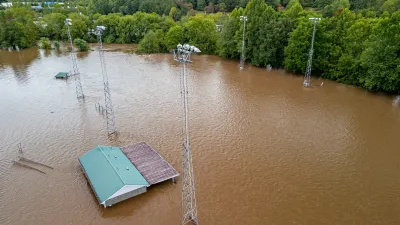New Jersey has to decide how to protect homes, roads and development from future storms. The Army Corps of Engineers has proposed to build protective sand dunes, but a small number of beachfront property owners refuse to allow the plan to proceed.

Superstorm Sandy destroyed nearly 82,000 homes and caused $7.8 billion in insured losses. New Jersey now has had to decide how best to protect homes, roads and development from future storms. The resulting debate is turning neighbors against each other in many communities along the coast.
Kate Zernike writes in The New York Times: "The corps had completed some dunes before Hurricane Sandy hit, but stopped when they could not get enough easements. Where there were dunes, the storm left relatively minor damage. Where there were not, homes — even many seemingly safely inland — were destroyed."
"...Pressure tactics have been aimed at persuading the more than 1,000 seaside homeowners on the southern part of the shore who are refusing to allow dune construction on their properties, in many cases to protect their ocean views. The measures have transformed a philosophical battle of property rights versus public good into a bitter neighbor-versus-neighbor ground war all along the coast."
After a recent court ruling suggesting that cities and counties would not need to compensate property owners for taking easements along the beachfront, many communities are now considering eminent domain proceedings against the holdout property owners.
FULL STORY: Dunes Fight Sets Neighbor Against Neighbor in New Jersey

Planetizen Federal Action Tracker
A weekly monitor of how Trump’s orders and actions are impacting planners and planning in America.

Maui's Vacation Rental Debate Turns Ugly
Verbal attacks, misinformation campaigns and fistfights plague a high-stakes debate to convert thousands of vacation rentals into long-term housing.

Restaurant Patios Were a Pandemic Win — Why Were They so Hard to Keep?
Social distancing requirements and changes in travel patterns prompted cities to pilot new uses for street and sidewalk space. Then it got complicated.

In California Battle of Housing vs. Environment, Housing Just Won
A new state law significantly limits the power of CEQA, an environmental review law that served as a powerful tool for blocking new development.

Boulder Eliminates Parking Minimums Citywide
Officials estimate the cost of building a single underground parking space at up to $100,000.

Orange County, Florida Adopts Largest US “Sprawl Repair” Code
The ‘Orange Code’ seeks to rectify decades of sprawl-inducing, car-oriented development.
Urban Design for Planners 1: Software Tools
This six-course series explores essential urban design concepts using open source software and equips planners with the tools they need to participate fully in the urban design process.
Planning for Universal Design
Learn the tools for implementing Universal Design in planning regulations.
Heyer Gruel & Associates PA
JM Goldson LLC
Custer County Colorado
City of Camden Redevelopment Agency
City of Astoria
Transportation Research & Education Center (TREC) at Portland State University
Jefferson Parish Government
Camden Redevelopment Agency
City of Claremont





























